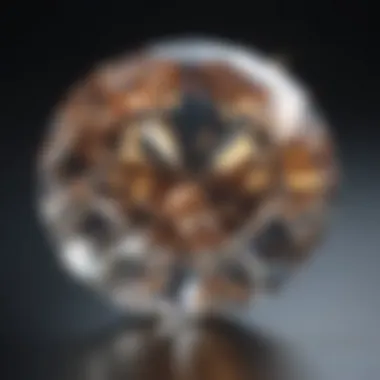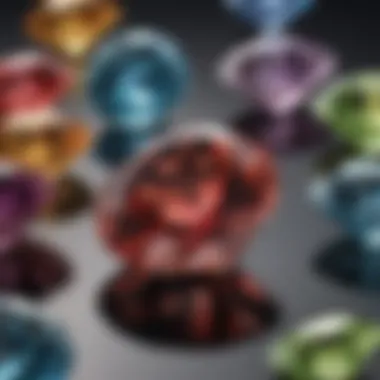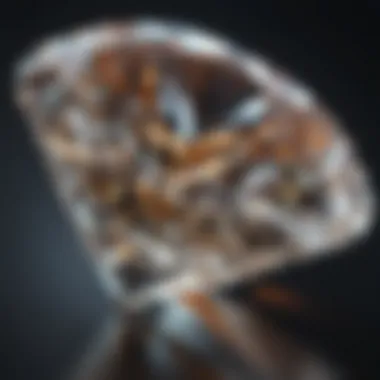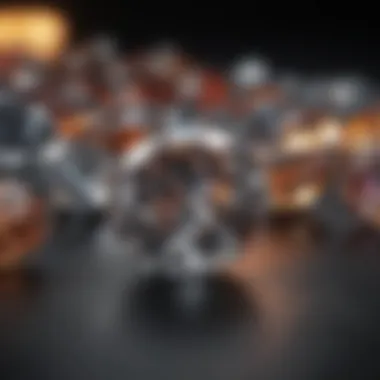Understanding the Value of Diamonds: A Comprehensive Guide


Intro
Diamonds, as timeless symbols of beauty and status, deserve more than a cursory glance. Their allure lies not only in their brilliance but also in the complex factors that determine their value. In today’s world, understanding this value goes beyond surface-level appreciation, encompassing deeper insights into market dynamics, personal preferences, and the science of gemstones. This compendium aims to navigate the intricate layers of diamond valuation, providing readers with the knowledge needed to appreciate their worth fully.
Let’s dive into the backbone of diamond assessment and reveal what truly sets certain stones apart from others.
Gemstone Overview
Definition and Origins
Diamonds are formed deep within the Earth’s mantle under intense pressure and heat, primarily consisting of carbon atoms arranged in a crystal lattice structure. Their formation can take billions of years, leading to a rarity that adds to their allure. From their discovery in ancient India to today's expansive mining operations in Russia, Botswana, and Canada, diamonds have a storied history as both adornments and symbols of power.
"Diamonds are the hardest natural substance known on Earth, but their creation is a process fraught with adversity and geological upheaval."
Historical Significance
Throughout history, diamonds have been imbued with meanings transcending mere monetary value. In ancient civilizations, they were believed to possess protective qualities, symbolizing strength and courage. Fast forward to the modern era, and these stones have become synonymous with love, epitomizing commitment and often marking pivotal life events like engagements and weddings.
Their historical journey reflects societal values and changes, making diamonds not just a financial asset but also a cultural one.
Gemstone Properties
Hardness and Durability
When it comes to gemstones, toughness often takes center stage, and diamonds shine in this regard. Rated a perfect 10 on the Mohs scale of mineral hardness, their durability makes them ideal for everyday wear. However, it's crucial to note that while they can withstand scratches, they are still susceptible to being chipped or damaged if struck against a hard surface. This dichotomy is essential for buyers to consider when evaluating diamond jewelry.
Color and Clarity
Diamonds are most often revered for their pristine clarity and captivating color. Both factors play pivotal roles in determining their quality and, consequently, their value. Here’s a breakdown of what to look for:
- Color: Diamonds range in color from colorless (which is highly prized) to shades of yellow, brown, and even rare hues like pink or blue. Each variation carries its own worth.
- Clarity: This characteristic assesses the absence of inclusions or blemishes. A stone with fewer imperfections typically commands a higher price.
In essence, the interplay of color and clarity can dramatically alter a diamond's market value, rewarding those with a keen eye for quality.
Understanding these fundamental properties sets the groundwork for discerning the intricate and sometimes elusive value of diamonds, guiding potential buyers in making informed decisions. As we continue, we will delve into the nuanced criteria that experts use to evaluate these amazing gems, unraveling the ‘Four Cs’ that serve as a compass in the journey of diamond appraisal.
The Fundamentals of Diamond Pricing
When diving into the realm of diamonds, one might wonder what lays the foundation for their pricing. Understanding the fundamentals of diamond pricing goes beyond mere numbers attached to a piece of jewelry; it allows buyers to make informed decisions, appreciate the craftsmanship involved, and gauge the true value of their investment. In this section, we will elucidate the intrinsic elements that influence diamond value and shine light on the considerations that buyers should keep in mind.
An Overview of Diamond Value
At its core, diamond value encompasses a variety of factors that interplay to set the price of a stone. Key components often cited include the Four Cs: cut, color, clarity, and carat weight. Each of these attributes provides a unique insight into the diamond's characteristics:
- Cut: Refers to how well a diamond has been shaped and polished. The quality of the cut not only affects the stone's symmetry and brilliance but also its ability to reflect light.
- Color: While many may assume that colorless diamonds are the most desirable, the truth is that colored diamonds, like fancy vivid pinks or blues, can command jaw-dropping prices due to their rarity.
- Clarity: Inclusions and blemishes are natural features of diamonds. The fewer imperfections a stone has, the higher its clarity grade, which often translates to a higher value.
- Carat Weight: Larger diamonds are rarer and generally more valuable, but this doesn’t always mean a proportional increase in price. The supply and demand for larger stones can create a different pricing dynamic.


Understanding these core attributes provides a fundamental basis for grasping why one diamond is valued higher than another. However, inherent diamond qualities are only part of the picture, as other determining aspects come into play.
Why Diamonds Are Considered Valuable
The perceived value of diamonds often stems from a confluence of historical, cultural, and economic factors. For centuries, diamonds have been viewed not just as gemstones but as symbols of wealth, status, and love. Here are a few reasons why diamonds hold such an esteemed position:
- Cultural Significance: Events like engagements and weddings frequently feature diamonds, embedding them in societal traditions, thus boosting their allure and perceived value.
- Rarity: While not the rarest stones on earth, diamonds are still considered precious and, depending on their type, can be exceedingly rare. This rarity plays a significant role in their pricing.
- Market Demand: The demand for diamonds tends to fluctuate based on social trends and economic conditions. A rising interest in sustainable jewelry or lab-created diamonds, for example, has lately begun to impact traditional diamond pricing.
- Emotional Connection: The emotional weight attached to diamonds, often associated with love and commitment, can inflate their perceived value beyond mere economics.
"The diamond is forever, not because it's the hardest substance, but because it symbolizes something that transcends mere material value."
Ultimately, the value placed on diamonds is not solely a function of their physical qualities but rather a complex interplay of sociocultural factors and economic conditions. This understanding is essential for anyone looking to invest in diamonds, as it provides a more nuanced view of their worth in the market.
The Four Cs: The Cornerstones of Diamond Assessment
The Four Cs—cut, color, clarity, and carat weight—serve as the fundamental pillars in evaluating diamonds. They offer not just a guideline for fixed pricing but also a framework for understanding a diamond’s aesthetic appeal and overall value. Engaging with each of these components helps potential buyers or collectors alike to make informed decisions when navigating the sometimes murky waters of diamond purchasing.
When someone mentions the Four Cs, it often evokes the image of sparkling gems under tailored lighting. However, there’s more than just sheer beauty involved; each of these factors influences not only the appearance of the diamond but also its market value. Understanding these characteristics can empower buyers, ensuring their investments are thoughtful and well-placed.
Cut: The Importance of Shape and Quality
Cut refers to how well a diamond has been shaped and polished, affecting how light interacts with it. This element determines the fire, brilliance, and scintillation of the diamond. A diamond cut poorly can result in dullness even if its clarity and color are exceptional. The shape is the first thing that catches the eye; whether it’s a classic round or a fancy princess cut, it can also reflect the stylistic preferences of the wearer. Common considerations include:
- Proportions: This decides how well light flows through the diamond. Too deep or too shallow results hinder beauty.
- Symmetry: All sides should mirror each other; imperfections in symmetry can detract from the overall allure.
- Polish: How smooth is the surface? A highly polished diamond reflects light beautifully.
Even minor discrepancies in cut can lead to substantial price variations, making it paramount for buyers to grasp the nuances of this critical aspect.
Color: The Spectrum of Diamond Hues
Diamond color is graded based on the absence of color, not how vibrant a stone may be. While colorless diamonds are traditionally viewed as the most valuable, fancy colored diamonds (like pink or blue) present a different set of values altogether. This grading is typically done on a scale from D (colorless) to Z (light yellow or brown). This scale is crucial for buyers as it helps them understand how color intensity can reflect desirability and worth. Notably:
- Fluorescence: Some diamonds exhibit fluorescence under UV light. This can either diminish or enhance the diamond’s overall appearance depending on the color.
- Shades of Color: While many aim for colorless diamonds, certain shades can enhance desirability significantly, impacting the price accordingly.
Understanding these subtleties enables collectors and enthusiasts to appreciate the spectrum of choices available.
Clarity: Understanding Inclusions and Blemishes
Clarity is all about the presence, type, and location of inclusions—internal flaws—and blemishes—external imperfections. The clarity grade usually ranges from Flawless to Included. A flawless diamond is a tough find, and thus often carries a hefty price tag. Here are key features:
- Inclusions: These can be anything from tiny specks to large clouds. The fewer inclusions, the clearer the diamond, enhancing its visual appeal.
- Blemishes: A scratch or chip can drastically affect market value.
"When it comes to clarity, a little bit of knowledge goes a long way. Many buyers dismiss inclusions when a small imperfection could lead to significant savings without ditching beauty."
Understanding clarity allows potential buyers to grasp how these imperfections impact not just the aesthetics but also the diamond’s potential longevity and resale value.
Carat Weight: More Than Just Size


Carat weight refers to how heavy a diamond is. Often, larger stones carry higher prices, but weight isn't the only factor at play. The increase in price doesn’t follow a straight line, and often, a jump from a 0.90-carat to a 1-carat can show a disproportionate jump in price. When evaluating carat weight, consider:
- Size Comparisons: Different shapes can make a 1-carat diamond look smaller or larger based on proportions.
- Value Relationship: Larger carat weights tend to inflate prices significantly more than quality metrics.
Understanding carat weight as one piece of a large puzzle is essential for strategic purchasing.
By grasping the significance of the Four Cs, buyers can approach their diamond journeys with confidence and insight. Each C presents a layer of richness, guiding choices that rely on personal taste, budget, and the desired prestigious aura of the precious stones.
Beyond the Four Cs: Additional Value Determinants
While the Four Cs of diamonds are often regarded as the blueprint to value assessment, there lies a treasure trove of other factors that also deserve consideration. These additional determinants can sway both the market price and the sentimental worth of a diamond. Understanding these elements will not only enhance your appreciation of these gemstones but also equip you with knowledge that could guide your purchasing decisions.
The Role of Certification and Appraisal
The importance of certification cannot be overstated in the diamond world. Certification from recognized gemological laboratories, such as the Gemological Institute of America (GIA) or the European Gemological Laboratory (EGL), acts like a gold star on a student's report card. It ensures that the diamond has been meticulously graded and evaluated by experts. A proper certification provides clear documentation of the diamond's characteristics, including its cut, color, clarity, and carat weight. With such information in hand, buyers can rest assured that they're not losing their shirt and are receiving the quality they expect for their investment.
When it comes to appraisal, this process dives deeper than just standard grading. An appraisal factors in market conditions and anticipated trends—something that's pivotal especially for insurance purposes. For instance, once a diamond has been appraised, its value can be determined not just by the Four Cs, but also by your local market fluctuations. Having a professional appraisal done offers clarity on worth, which is key if you ever decide to resell or upgrade your piece.
Market Demand and Economic Factors
The demand for diamonds can shift like the winds, influenced by economic conditions, trends in fashion, and changing consumer preferences. For example, during economically prosperous times, diamond sales might soar as more people are willing to make splurges on engagement rings or luxury jewelry. Conversely, during a recession, that sparkle might lose some of its allure, affecting prices across the board.
Broader trends, such as the rise of lab-grown diamonds, have also impacted traditional diamond pricing. With alternatives becoming more accessible and socially accepted, diamond stones might find themselves in a competitive pricing landscape. It's also worth noting that different demographics have differing tastes; Millennials, for instance, tend to prefer ethical and sustainable sourcing, which can drastically affect the value of ethically sourced diamonds.
Rarity and Origin: Pricing Influences
Rarity plays a pivotal role in determining a diamond's price. Just as a one-of-a-kind painting by a renowned artist fetches millions at an auction, so too can a uniquely colored diamond command a remarkable premium. Pink, blue, and green diamonds, often referred to as "fancy colors," are much rarer and thus, their prices can skyrocket due to their limited availability.
Moreover, the origin of a diamond can greatly influence its value. Diamonds sourced from regions with a reputation for quality and ethical mining, like the countries in the Gemisphere, often attract a higher price tag. The market does pay attention to the ethical implications behind its gems, making provenance a significant factor for discerning buyers.
"Understanding the additional value determinants enhances your ability to make an informed purchasing decision and appreciate what the diamond truly represents."
Common Misconceptions About Diamond Pricing
In the intricate world of diamonds, misunderstandings and myths can easily cloud the wisdom of a potential buyer. The significance of addressing common misconceptions about diamond pricing lies not only in demystifying the marketplace but also in empowering buyers to make informed choices. Understanding these misconceptions enhances one's ability to discern real value amidst a labyrinth of price tags, advertisements, and emotional appeals that can sometimes skew perception. This section seeks to clear the fog from the diamond buying process, allowing enthusiasts to see the gems for what they truly are.
Debunking Myths About Price Tags
When it comes to diamonds, the price tag can be a source of confusion and, at times, anxiety. One prevalent myth is that higher prices always equate to better quality. This notion is far from the truth. The perceived value of a diamond is often influenced by factors unrelated to its physical attributes. For instance, time-sensitive trends and celebrity endorsements can create a spike in demand, leading to inflated prices without a corresponding increase in quality.
Consider this: a stunning diamond can have a modest price tag simply because it isn't the hottest trend at the moment. Conversely, a diamond that might look good for a billboard advertisement could be pricier than its worth due to marketing tactics and branding. Buyers should always focus on the Four Cs - cut, color, clarity, and carat weight - for a clear assessment of value instead of fixating on the price alone.
"Quality is remembered long after the price is forgotten."
This adage aptly reflects the reality many discover after investing in a diamond. It highlights the importance of staying informed and looking beyond mere price tags.


The Impact of Branding on Prices
Branding plays a significant part in the diamond industry. Many players, particularly luxury jewelry brands, capitalize on their names, which can lead to sticker shock for many buyers. A diamond sold under a well-known name often carries a price premium that may not reflect its intrinsic quality. This isn't to say that branded diamonds lack quality, but the brand often capitalizes on its reputation.
When selecting a diamond, it's prudent to consider whether the branding enhances value in a meaningful way. Here are some key points to contemplate:
- Brand Recognition: Recognizable brands can signify a certain level of quality assurance, but this comes at a cost.
- Certification: Many respected brands ensure that their diamonds are certified, which helps legitimize their pricing.
- Emotional Value: For some, buying a diamond from a prestigious brand carries emotional weight, contributing to its perceived value.
Guidance for Potential Buyers
When it comes to investing in diamonds, having a clear roadmap is just as essential as knowing the carats and clarity. This section sheds light on why guidance for potential buyers is so crucial in this multifaceted world of gemstones. Diamonds are not merely pieces of jewelry; they are valuable assets, and understanding how to navigate this terrain can make a significant difference in both satisfaction and value.
Shopping Wisely: Tips for Buyers
So, where do you even start? First, know your budget. Diamonds come in many price ranges, and setting limits can help you avoid heartbreak down the line.
- Do Your Research: Familiarize yourself with the Four Cs — cut, color, clarity, and carat weight. Understanding these factors means you're not walking in blind.
- Buy Certified Stones: Always look for diamonds accompanied by a grading certificate, like those from the Gemological Institute of America or the American Gem Society. This proves you’re getting what you pay for.
- Shop Around: Don’t just settle for the first deal you come across. Prices can vary significantly between retailers, from local jewelers to online stores.
- Ask Questions: Don’t be shy! Inquire about the diamond's history, especially if it’s a vintage piece. This can reveal information about its quality and origin, which might influence its value.
Buying a diamond doesn't have to be a stressful endeavor, but it does require a bit of homework.
Recognizing Great Value: Prioritizing Quality
Recognizing what constitutes great value in a diamond is not as easy as it sounds. Many buyers are easily swayed by a gleaming stone but fail to consider underlying factors.
- Focus on Cut First: The cut of a diamond greatly influences its brilliance. A well-cut stone can often outshine others of higher carat weight.
- Clarity Matters: While imperfections may be invisible to the naked eye, they can drastically affect a stone's value. Aim to find that sweet spot where you have good clarity without sacrificing size or color.
- Consider Color Preferences: Depending on your taste, color quality may vary in importance. A diamond with slightly lower color quality may present significant savings without compromising aesthetic beauty.
- Think Long-term: Diamonds should be seen as investments. Prioritizing higher quality now can mean retaining value longer down the road.
"A diamond is forever, and so is the value if you choose wisely."
Through these tips, navigating the world of diamonds becomes a much less daunting task. Ultimately, knowledge is power. Making informed decisions will guide you toward a beautiful gemstone that aligns with both your sentimental and financial aspirations.
End: Making Informed Decisions
Navigating the intricate world of diamonds can feel like walking through a minefield. With so many factors at play, understanding the true value of a diamond is vital not just for enthusiasts, but also for buyers looking to invest in a lasting piece of beauty. This conclusion aims to highlight the importance of gathering knowledge before making decisions, ensuring buyers can assess their options with clarity and confidence.
Summarizing Key Points
As we wrap up this guide, let’s recap the essential points that frame our understanding of diamond value:
- The Four Cs
- Beyond the Four Cs
- Common Misconceptions
- Practical Guidance
- Cut, which defines not only the shape but also how light interacts with the diamond. Choose wisely, as it enhances the stone’s brilliance and fire.
- Color reveals the hue spectrum, showing us that subtle variations can significantly affect price. A diamond's purity of color might be what the eye notices first.
- Clarity brings attention to the internal characteristics or inclusions, shaping the story each diamond tells. Even the tiniest imperfections can have a notable impact on value.
- Carat weight is the measurement that often grabs attention, but it’s more than just size—weight connects to rarity.
- Certification from reputable bodies lends credibility to the stone’s assessed value. Knowing who appraises your diamond can save you a heap of regret later on.
- Keep an eye on market dynamics. Economic trends and changing consumer demands can shift diamond prices unexpectedly.
- Rarity and origin also play pivotal roles. The provenance, especially if tied to historical significance or famed diamond mines, adds compelling value.
- Price tags can often mislead. Understand the factors behind them, and you might pick up a prized gem without breaking the bank.
- Branding also contorts perceptions of worth. Sometimes, paying for a name can overshadow the stone’s intrinsic value.
- Always take your time to shop wisely. Distinguish between wants and needs. An informed buyer can spot a genuine deal versus a mere allure.
- Prioritize quality over quantity. It’s far better to own a smaller, stunning diamond than a large, lackluster one.
As you sift through options, remember that knowledgeable choices tend to yield the best long-term satisfaction. Take into account the nuances discussed, and you may not only leave with a beautiful piece but also with a sound investment.
"The true value of a diamond lies not just in its brilliance, but in the knowledge that guides its selection."
With this wisdom and clarity, buyers can approach the diamond market with a critical yet appreciative eye, ensuring that their decisions resonate well beyond the initial purchase.



